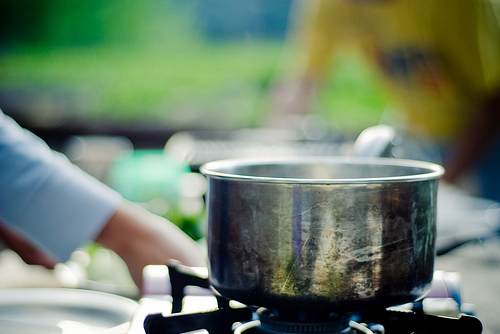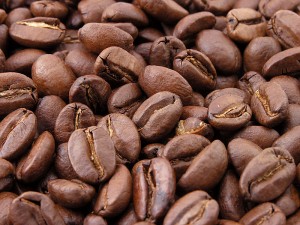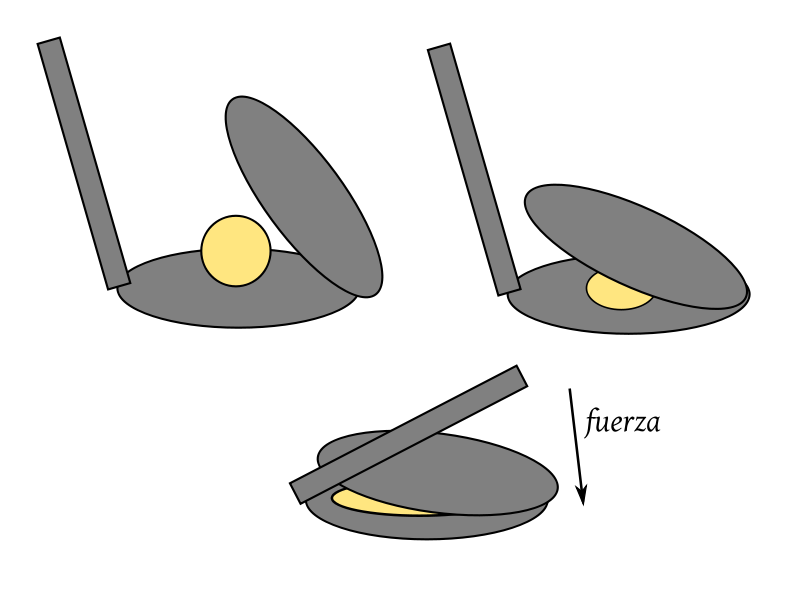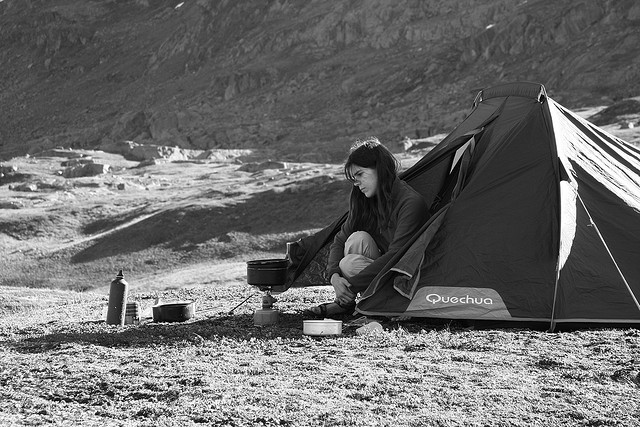My culinary horizons started their slow expansion when I was 21 and wearing Carhartts so dirty that they could stand up by themselves. After a day spent measuring trees at a forest research station, the grad student I was working with had offered to make dinner. When I asked what I can do to help, he handed me a handful of green stuff.
It smelled sort of familiar. “What do I do with this, exactly?” I asked. He furrowed his brows at me—not unlike the expression he’d worn for most of the day as I mixed up Douglas and white fir.
But this time, he sounded more incredulous. “You don’t know what cilantro is?”
Eating in the field can have the same dislocated, heightened quality that accompanies foreign travel. Far from the comforts of home, you find yourself cooking with people who you’ve only ever seen hunched over a lab bench. (You mean, they eat, too?).
And the result can be more than palate-cleansing. I’m just guessing here, but it seems like field researchers are a self-selected bunch who don’t mind experimenting in far-flung locales (and can often take pleasure in focusing on the tiniest of details). Why wouldn’t they also be fascinated by food?
Sometimes, the fine cuisine can be a direct result of research. Science journalist Douglas Fox once spent time on Heron Island, a part of the Great Barrier Reef, with researchers studying fish vision—researchers who traveled with wasabi and soy sauce. At night, after they harvested a fish’s eyes for their study, they’d call to Fox to come and get the rest to fillet. He saw the whole process—from ocean to lab to plate—and got to eat fish that he’d never find in a restaurant. His favorite: trevally sashimi.
(Of course, some research doesn’t mix well with food. While staying with a crew of researchers for a story, freelance journalist Hillary Rosner discovered that one of the fridge’s produce bins held DNA analysis material—in the form of tiny snips of deer mouse tails. She stored her veggies in the other produce bin.)
Fieldwork also requires creative cooking techniques. During Anne Sasso’s first geology field job, she learned about more than just volcanic rocks in the Yukon’s St. Elias Mountains. The graduate student she worked with taught her how to bake loose versions of chocolate chip cookies, rolls, and apple pie (in a gold pan) in a one-gallon Coleman fuel canister-turned-reflective oven.
 Later, when Sasso conducted her own doctoral work in Argentina, her assistant would use their house’s electric space heater to broil open-face sandwiches with cheese and tomato sauce on local-style rolls. Says Sasso, founder of WaterRock Communications, “I think he got a few shocks. The whole electrical circuitry in our ‘house’ (generous term) was suspect.”
Later, when Sasso conducted her own doctoral work in Argentina, her assistant would use their house’s electric space heater to broil open-face sandwiches with cheese and tomato sauce on local-style rolls. Says Sasso, founder of WaterRock Communications, “I think he got a few shocks. The whole electrical circuitry in our ‘house’ (generous term) was suspect.”
Not all experiments pan out. Science journalist Emily Sohn was on a multi-media reporting trip in the Peruvian Amazon when, after a series of unfortunate events (venomous sting rays, killer bees, vampire bats, thunderstorm, flash flood, and finally, a flipped raft), she and her group were living on canned tuna, saltines, and bananas.
Sohn, consumed with improving on their lot, had an inspiration: tuna balls. The idea: a combination of tuna, mashed-up saltines, and possibly another binding agent, all fried. Her description of the results:
“I had imagined something like croquettes. The reality was very different. We each got two or three of them. We stood there, around a fire, gulping them down. Nobody said a word. Despite our meager rations, some were left uneaten. Then, silently, we crawled into our tents and went to sleep.”
After hearing all of these stories, I was left feeling like my own fieldwork-and-cooking adventures reflected less on any groundbreaking meals (or research, for that matter), and more on my lack of culinary savvy. In fact, the first thing I thought of when I started remembering a summer-long stint at Toolik Field Station in Alaska was that it was where I first earned how to make coffee with a drip filter. (Peet’s Major Dickason’s Blend. Does that make me sound like less of an idiot? No?)
But food memories, even from someone who doesn’t know much about food, still elicit powerful memories of something beyond just the place. I’ve spent the last few days emailing with Laurie Gold, a University of Washington epidemiologist who spent the summer with me, picking tiny tundra plants. We have been reminiscing about Alaskan Amber, the legendary 4th of July feast, the chocolate-covered espresso beans that we nicknamed “X pills,” X being the real name of our indefatigable, ever-cheerful PI.
From our hilltop study site, we could see the dust of eighteen-wheelers coming down the haul road and, we hoped, carrying mail for us. Our families sent us care packages with more coffee, Clif Bars, other treats. But the biggest treat of the summer was when one of the truckers arrived with California nectarines.
Adding seasoning to all of these memories are the Arctic sun, the call of the loons, the permafrost melting underneath our feet, the sensitive, intertwined fauna of an ecosystem that will show how the climate warms, and how soon.
On the rare occasion that I make a cup of coffee, somewhere I am still standing in my mosquito-proof shirt and XTRATUF boots, doling out a tablespoon into the filter before heading out. And somewhere, still, are those fragile, hardy tundra plants.
The most extreme example of someone who’s intertwined his love for food and science that I’ve met is ornithologist Walt Koenig. He’s spent several decades studying acorn woodpeckers at a California natural reserve . Each September, he embarks on a statewide acorn counting trip that, along with understanding the variability of an important food source for California wildlife, is a good excuse for Koenig to visit as many taquerias as possible. (He writes an annual newsletter about his research, complete with restaurant reviews).
When I interviewed Koenig at the reserve a few years ago, he somehow ended up cooking every meal for me. (Had someone told him about my kitchen skills?) One afternoon, he pulled together killer crab quesadillas from the dregs of his cupboards, and much of our conversation beyond woodpeckers focused on the scarcity of his favorite foods in upstate New York, where he’s now based.
Koenig told me that his kids liked his homemade tortillas so much that they refused to eat tortillas from anywhere else. Inspired, I bought a tortilla press.

Now, every time I make tortillas, I think of acorn woodpeckers and their crazily complicated family structures, their enormous granaries of acorns. And I think of Koenig, who’s either eating a taco right now or wishing he were.
The tortillas: you should try them. You can put almost anything on them and they taste delicious. Even tuna balls would work. Especially with a little bit of cilantro.
***
Images:
Top: Jan Van Winkel
Next: Benjamin Chan
Next: MarkSweep
Last: Drini

Cam,
Your article brought back memories for me – backpacking in the High Sierra before the days of trail food and tiny stoves. Memories of trout seasoned with sage and wild onions and grilled over a grid of willow branches. The simple life hss an appeal.
For me your use of language resembles an artist choosing which brush and which tube of color to use to express her vision of her work. Keep painting!
Karl
Cameron,
what a delightful deliciously intriguing article…I’m captured by your words!
I haven’t personally been to Toolik, but as a Fairbanks student assistant for Bonanza Creek, my Monday Morning just got a lot brighter with the shout out to Alaska, Toolik, Xtra Tufs, and Carhartts. Alaska summers are best spent in the field with a bottle of bug dope in one hand and a circle of pilot bread in the other.